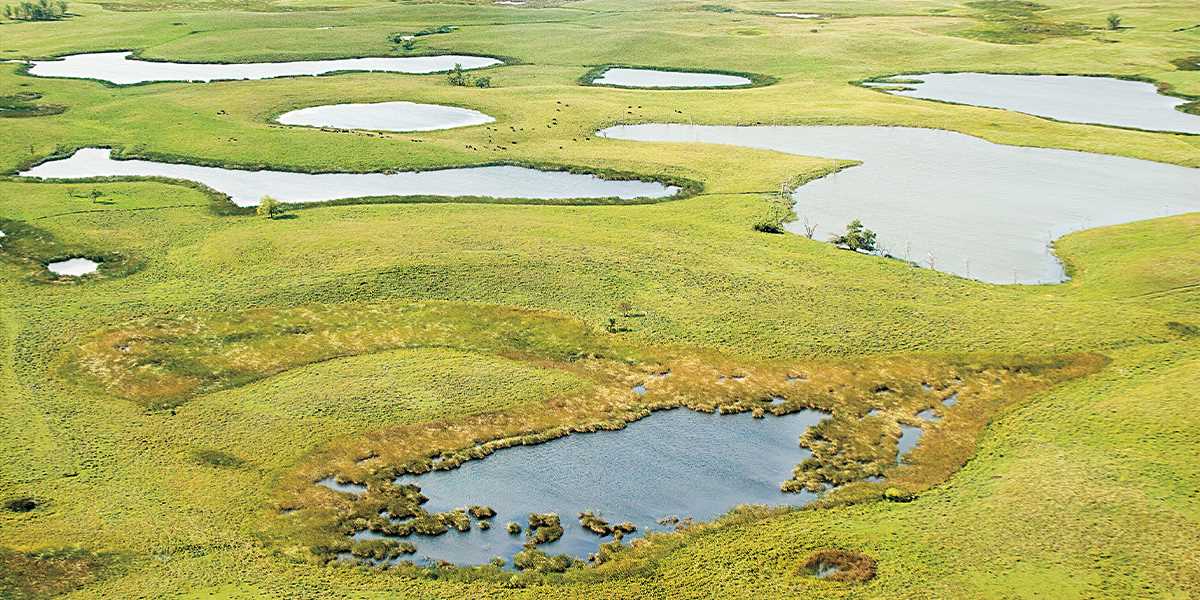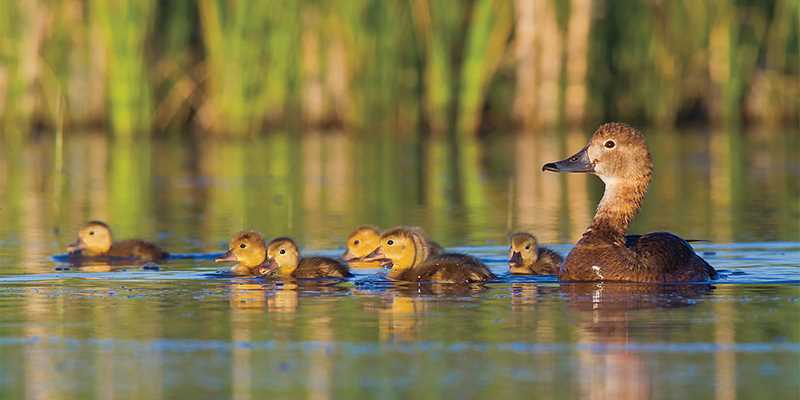Understanding Waterfowl: Prairie Potholes and Breeding Ducks
Conserving these small, shallow wetlands is essential to the health of continental duck populations
Conserving these small, shallow wetlands is essential to the health of continental duck populations
By Kaylan Kemink and Tanner Gue

The Prairie Pothole Region (PPR) is a bucket-list destination for many waterfowlers. Cool, crisp prairie skies filled with ducks and geese draw hunters from across the continent each October. Less well-known, however, are the unique geologic and hydrologic features that make this area of the northern plains so important to waterfowl and other wetland wildlife.
Spanning more than 300,000 square miles across the north-central United States and southern Canada, the PPR was shaped 10,000 years ago by a massive receding glacier that left behind sediment deposits, creating numerous depressions in the ground called potholes. Millions of these small, shallow wetland basins, most of which hold water for only part of the spring and summer each year, provide vital food and cover for many species of ducks during the breeding season.
Breeding duck populations on the prairies are driven by the density of flooded potholes on the landscape in spring. Each year, female ducks bring their mates back north with them to the prairies. Breeding pairs settle on shallow ponds rich with invertebrates, where they establish territories. Females feed as much as possible during this period to acquire the resources they need for egg laying and incubation, while males spend most of their time posturing and defending their mates and territories from competitors. When other pairs of the same species get too close to a drake's territory, aggressive encounters and even fights often ensue. As a result, landscapes with high densities of small wetlands, where numerous breeding pairs can establish territories away from other pairs, support more breeding ducks on average than areas with a few large, consolidated wetlands.
The relationship between breeding ducks and small ponds often gets overlooked in favor of the relationship between grassland and nesting success. While there is ample evidence for the latter, research has revealed that the density and productivity of small wetlands is of equal if not greater importance to breeding waterfowl than the quantity of upland cover on the landscape. In fact, more than 70 percent of breeding ducks in the US portion of the PPR settle in cropland-dominated areas that contain high densities of small, shallow wetlands. Research has underscored the importance of protecting wetlands on these landscapes despite the lack of surrounding grassland because they still provide crucial resources for breeding ducks. The highly variable, seasonal nature of these wetlands promotes the growth of submerged vegetation and supports abundant invertebrate populations, which provide nesting hens with the protein and calcium required to produce eggs and sustain them during incubation.

Duck broods also depend on small, seasonal wetlands. For example, recent research conducted by Ducks Unlimited and the US Fish and Wildlife Service demonstrated that the loss of small wetlands can have an even larger impact on brood abundance than the loss of grassland habitat. Grasslands are undoubtedly important for duck production, but without high densities of small wetlands, the quality and quantity of surrounding upland cover becomes less relevant. The results of this research further emphasized the importance of conserving small prairie wetlands, including those embedded in cropland.
In addition to the vital importance of prairie potholes to breeding pairs and broods, these small wetlands also benefit people directly by improving the quality of the water supply. Using cutting-edge research techniques, scientists recently compared the isotopic signatures of water in different wetland types to the isotopic signature of groundwater on the prairies. Their findings indicated that the water in small, seasonally flooded wetlands, which are so productive for breeding ducks, had an isotopic signature very similar to that of groundwater. As a result, the researchers concluded that prairie potholes could be a major source of groundwater recharge in the region. Recharge is the process by which surface water replenishes the underlying aquifer, which is the main source of drinking water for people in many areas.
It is concerning that small prairie wetlands, which clearly have such great value to wildlife and people, are at high risk of conversion because they are easier to drain than other wetland types. Prairie pothole wetlands are viewed as an additional cost to some agriculture operations because they provide lower yields when dry, are sometimes unfarmable, and farmers often must work around them with large, sometimes unwieldy machinery. Consequently, draining small wetlands, particularly those embedded in cropland, is a common practice on the prairies. While some areas of the PPR have lost 90 percent of their wetland habitats, in other areas farmers have left the majority of wetlands intact. DU and others are focused on supporting those farmers and ensuring the remaining habitats retain their value for wildlife.
Protecting small prairie wetlands is among DU's highest priorities. The vast majority of the PPR is privately owned by hardworking farmers and ranchers. Recognizing the goals of producers, DU works closely with private landowners, state and federal agencies, and other partners to deliver a variety of voluntary, incentive-based conservation programs on working lands. Programs like the Minnesota Outdoor Heritage Fund, North Dakota Outdoor Heritage Fund, North American Wetlands Conservation Act, and Wetlands Reserve Program all provide farmers and ranchers with voluntary incentives to keep small wetlands, and all the benefits they provide, on the landscape.
Fortunately, an array of diverse agricultural practices go hand in hand with wetlands and waterfowl conservation. Through these efforts, DU is working with farmers and ranchers to improve the profitability of their operations while keeping small wetlands, waterfowl, and other wildlife on the prairie landscape for current and future generations.
Kaylan Kemink is manager of conservation planning and Tanner Gue is a regional biologist in DU's Great Plains Region.
.jpg)
Conservation easements benefit producers and protect wetlands on agricultural lands in perpetuity.
Perpetual conservation easements are the backbone of DU's habitat protection efforts in the Prairie Pothole Region. These voluntary agreements provide incentives for landowners to preserve wetlands in their natural state with a one-time payment based on a percentage of the land value. Landowners retain ownership of their property and can continue to use it for farming or ranching as long as wetlands are conserved. Perpetual easements are very popular with private landowners because they protect fundamental habitat values while also allowing producers to access capital that otherwise would be tied up in the land.
Since 1998, DU and the US Fish and Wildlife Service have perpetually protected more than 306,000 acres of wetlands many of which are embedded in crop land throughout the Prairie Pothole Region of North Dakota, South Dakota, and Montana. Funding for this program is provided by the North American Wetlands Conservation Act, the Migratory Bird Conservation Fund, the Land and Water Conservation Fund, Ducks Unlimited, and other sources. By supporting DU and buying federal duck stamps, you are helping to protect at-risk prairie wetlands forever.
For farmers and ranchers who do not wish to sell perpetual easements on their land, DU has developed a variety of shorter-term, working-lands conservation programs. These five- to 10-year agreements typically assume some of the financial risk faced by landowners who adopt new wildlife-friendly farming and ranching practices. They also help reduce incentives to drain small wetlands embedded in cropland. Through its new soil health initiative, for example, DU helps farmers and ranchers plant cover crops after their principal cash crop has been harvested. These cover crops provide high-quality forage for livestock and habitat for waterfowl and other wildlife species. Planting cover crops and implementing other soil-health practices improves the profitability of farms and ranches. In return, landowners keep wetlands embedded in cropland intact. Since its inception in 2016, DU's soil health initiative has directly benefited more than 4,500 acres of small wetlands on cropland-dominated landscapes in the US portion of the Prairie Pothole Region.
Ducks Unlimited uses cookies to enhance your browsing experience, optimize site functionality, analyze traffic, and deliver personalized advertising through third parties. By continuing to use this site, you agree to our use of cookies. View Privacy Policy